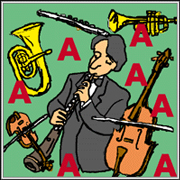Trivia
Why does the oboe lead the orchestra in tuning?
If you go to a concert performed by an orchestra, you will first hear the oboe play an A note (the standard tuning note) right before the performance starts, followed by each instrument playing an A and the entire orchestra tuning with one another. This moment announces the start of the concert and makes the audience's hearts race. This raises the question of why the oboe is in charge of playing the standard tuning note.
There are two explanations: The first is that it is because the oboe has a stable pitch, and the other is that it is because, instead, the pitch is unstable. The two explanations are the complete opposites of one another.
Nearly all instruments have always been unstable in terms of pitch because of differences in heat, humidity, and the like. Typically, the instruments come with mechanisms that allow performers to tune them. However, because of its structure, the oboe's pitch can only be changed by removing and inserting reeds. It is not possible to change how high-pitched the tones are the way that can be done by removing a clarinet's barrel or altering the tension of a violin's strings. The only way of altering the pitch of an oboe is to adjust the breadth or length of the reeds; it is nearly impossible to make any sudden changes on the day of a performance. It is difficult to adjust the pitch of an oboe. Therefore, it would appear that the other instruments in a performance must be made to match, and that is the explanation of why the oboe is the standard for tuning.

Musical Instrument Guide:Oboe Contents
Structure
How to Play
How the Instrument is Made
Choosing an Instrument
Trivia
- Why does the oboe lead the orchestra in tuning?
- Do the reeds have a front and a back?
- The keys recoil via springs!
- This is how the oboe and the cor anglais differ
- The charumera was the oboe's cousin
- You can reduce time spent breathing using circular-breathing techniques?
- The Wiener oboe that survived an existential crisis
- Oboe masterpieces: concertos
- Oboe masterpieces: chamber music
- What is the alto oboe?
- The heckelphone, which resembles the oboe
- The oboe is the bassoon's cousin
